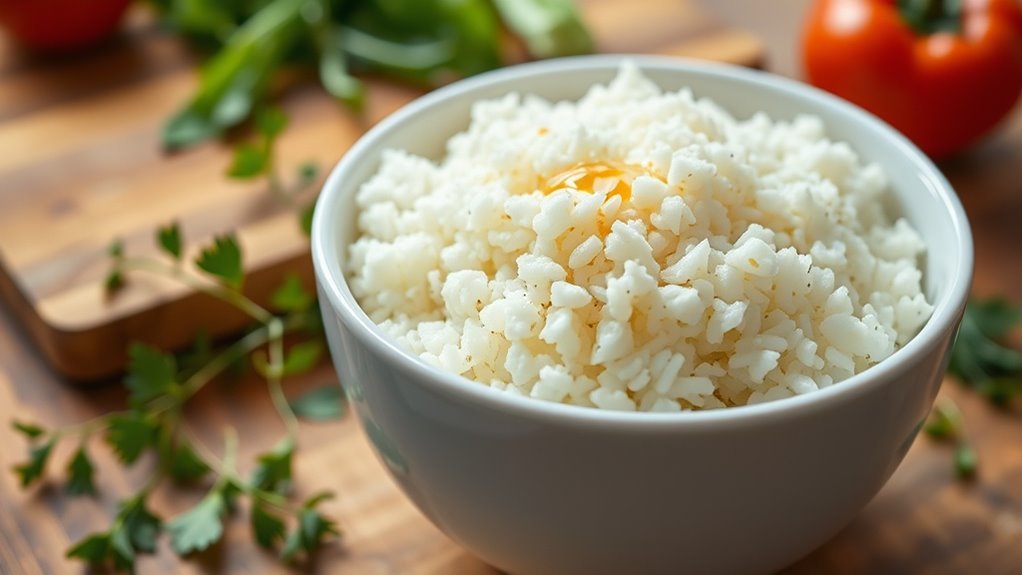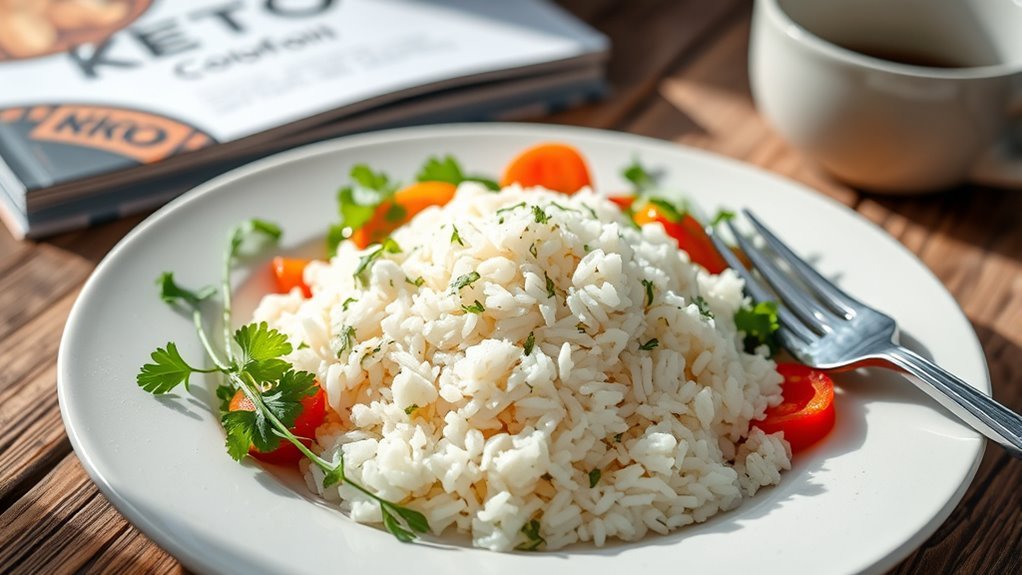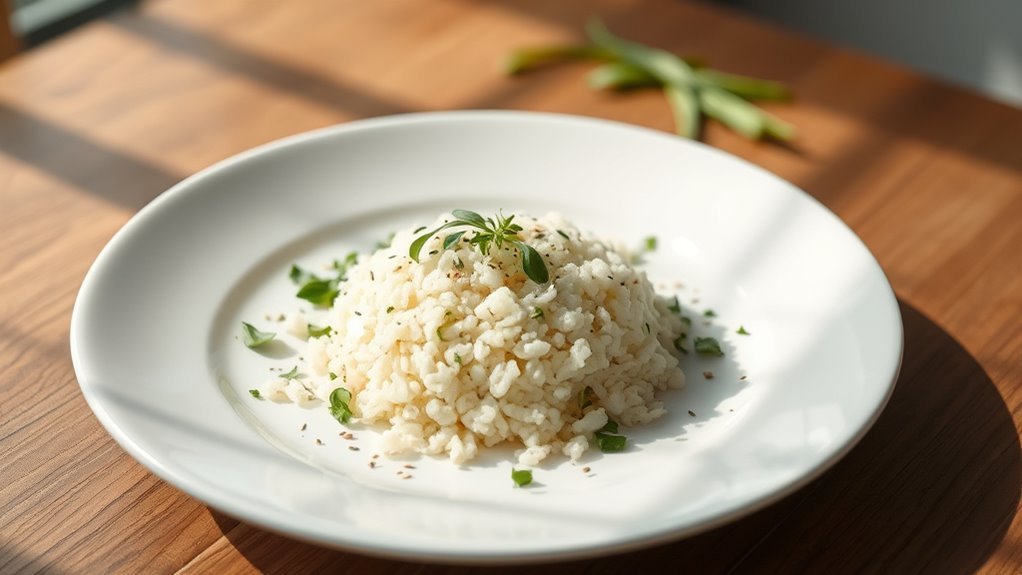You can’t have regular rice on a ketogenic diet due to its high carb content. One cup of cooked white rice has around 45 grams of carbohydrates, which can disrupt your state of ketosis. When you’re aiming to burn fat effectively, it’s essential to avoid high-carb foods like rice. Instead, consider low-carb rice alternatives, such as cauliflower or shirataki rice, which can offer a satisfying substitute in your meals. There’s more to explore about these alternatives.
Understanding the Ketogenic Diet

The ketogenic diet, often referred to as keto, is a high-fat, low-carbohydrate eating plan that aims to shift your body into a state of ketosis, where it burns fat for fuel instead of carbohydrates. By understanding the ketogenic principles, you can effectively navigate this lifestyle. Initially, your body relies on carbohydrates for energy, but as you reduce intake, it adapts to using fat, achieving what’s known as fat adaptation. This change can take days to weeks, depending on individual metabolism and adherence. Many people appreciate keto for its potential benefits, including weight loss and improved energy levels. Embracing this diet allows you to explore a diverse range of foods, promoting freedom while still adhering to its core principles.
Carbohydrate Content in Traditional Rice

Rice, a staple food for many cultures worldwide, is known for its high carbohydrate content. When you look at various rice types, such as white, brown, and jasmine, it’s clear they all contain significant amounts of carbs. For instance, one cup of cooked white rice has about 45 grams of carbohydrates, while brown rice contains roughly 50 grams. In a nutritional comparison, brown rice offers more fiber and nutrients than its white counterpart, but both still fall short for those on a strict keto diet. If you’re aiming for a low-carb lifestyle, understanding these differences can help you make informed choices. Ultimately, knowing the carbohydrate content in rice is essential for maintaining your personal dietary goals.
The Importance of Staying in Ketosis

Staying in ketosis is essential for reaping the full benefits of a ketogenic diet, as it helps your body efficiently burn fat for fuel. Carbohydrates can disrupt this state, leading to a shift back to glucose metabolism, which may hinder your weight loss and energy levels. Understanding how to maintain your ketogenic state can empower you to make better dietary choices, especially when it comes to foods like rice.
Understanding Ketosis Process
Achieving and maintaining ketosis is essential for anyone following a ketogenic diet, as it allows the body to efficiently burn fat for fuel instead of carbohydrates. The benefits of ketosis can be transformative, but you also face challenges along the way. Here are three key aspects to reflect on:
- Increased Energy: Once you’re in ketosis, your energy levels can soar, making daily activities easier and more enjoyable.
- Mental Clarity: Many people report improved focus and mental clarity, enhancing productivity and creativity.
- Weight Loss: Ketosis promotes fat loss, helping you feel lighter and more confident in your body.
Understanding these benefits and challenges can empower you to stay committed to your keto journey, giving you the freedom to thrive on this lifestyle.
Role of Carbohydrates
While it’s tempting to indulge in carbohydrates, keeping them in check is essential for maintaining ketosis. A balanced approach to carbohydrate sources can help you manage your carbohydrate metabolism effectively. By limiting carbs, your body shifts to burning fat for energy, promoting weight loss and improved energy levels.
Here’s a quick comparison of carbohydrate sources:
| Carbohydrate Source | Impact on Ketosis | Recommended Intake |
|---|---|---|
| Leafy Greens | Low impact | Unlimited |
| Berries | Moderate impact | ½ cup max |
| Whole Grains | High impact | Avoid |
| Low-Carb Veggies | Low impact | Unlimited |
| Sugary Foods | Very high impact | Avoid |
Maintaining Ketogenic State
To enjoy the benefits of a ketogenic lifestyle, it’s crucial to maintain your state of ketosis consistently. Staying in ketosis allows you to experience increased energy, improved mental clarity, and enhanced fat burning. Here are three key strategies to help you stick to your keto journey:
- Plan Your Meals: Effective meal prep guarantees you have keto-friendly options ready, reducing the temptation to stray.
- Stock Up on Keto Snacks: Keep tasty, low-carb snacks handy to curb cravings and avoid high-carb pitfalls.
- Monitor Your Macros: Regularly track your carbohydrate intake to stay within your limits and maintain ketosis.
Why Regular Rice Is Not Keto-Friendly
Although rice is a staple in many diets worldwide, it’s not considered keto-friendly due to its high carbohydrate content. One cup of cooked white rice can contain around 45 grams of carbs, which is a significant portion of the daily limit for those on a ketogenic diet. The rice glycemic index is also a concern; it often spikes blood sugar levels, further hindering your ability to stay in ketosis. Even small rice portion sizes can sabotage your efforts, as they can lead to cravings and hunger shortly after consumption. For those seeking freedom in their dietary choices, avoiding regular rice is vital to maintaining that low-carb lifestyle and achieving your health goals.
Exploring Low-Carb Rice Alternatives
If you’re looking for low-carb rice alternatives, you’ll find several options that can fit seamlessly into your ketogenic diet. These alternatives not only keep your carb count down but also add variety to your meals. Here are three great choices:
- Shirataki Rice: Made from konjac root, it’s incredibly low in calories and carbs, making it a fantastic rice substitute.
- Zucchini Rice: Grated zucchini can be sautéed to create a light, flavorful base for dishes like a veggie stir fry.
- Riceless Risotto: Use cauliflower or mushrooms instead of rice to create a creamy, satisfying dish without the carbs.
These options can help you stay on track while enjoying delicious meals, proving that you don’t have to sacrifice flavor on your keto journey.
Cauliflower Rice: A Popular Choice
Cauliflower rice has rapidly gained popularity as a go-to option for those on a ketogenic diet, primarily due to its versatility and low carbohydrate content. When you prepare cauliflower rice, you’re not just enjoying a rice substitute; you’re also reaping cauliflower benefits, such as high fiber and essential vitamins C and K. It’s a fantastic way to keep your meals colorful and nutrient-dense without sacrificing flavor. You can easily make it by grating or blending cauliflower florets and then sautéing them lightly. This preparation method allows you to create a base for stir-fries, bowls, or even as a side dish. Embracing cauliflower rice can help you maintain your keto lifestyle while enjoying satisfying meals that don’t weigh you down.
Shirataki Rice: The Zero-Calorie Option
Have you ever wondered how a food can be both filling and virtually calorie-free? Enter shirataki rice, a fantastic alternative for those on a keto diet. Made from konjac root, it’s often found in the form of shirataki noodles, offering impressive health benefits.
Here are three reasons to try shirataki rice:
- Weight Management: With zero calories, you can enjoy a generous serving without guilt.
- Digestive Support: It’s rich in glucomannan, a soluble fiber that aids digestion.
- Versatility: It absorbs flavors well, making it easy to incorporate into your favorite dishes.
Other Creative Low-Carb Rice Substitutes
While you might think rice is a staple that’s hard to replace on a low-carb diet, several creative substitutes can satisfy your cravings without derailing your keto goals. Cabbage rice is a fantastic option; simply chop or shred cabbage, then sauté it for a crunchy, flavorful alternative. It’s low in carbs and high in nutrients, making it a great addition to your meals. Another excellent choice is broccoli rice. By pulsing broccoli florets in a food processor, you can create a rice-like texture that’s rich in fiber and vitamins. Both options can easily absorb flavors from sauces and spices, allowing you to enjoy your favorite dishes while staying committed to your keto lifestyle.
Tips for Incorporating Rice Alternatives Into Your Meals
When it comes to incorporating rice alternatives into your meals, you’ve got some tasty options. Cauliflower rice, for instance, can easily absorb flavors and works well in a variety of dishes. Similarly, shirataki rice and zucchini rice can add unique textures while keeping your carb count low.
Cauliflower Rice Recipes
If you’re looking to cut carbs without sacrificing flavor, incorporating cauliflower rice into your meals can be a game changer. This versatile ingredient not only mimics traditional rice but also opens up a world of delicious possibilities. Here are three tempting recipes to try:
- Spicy Cauliflower Stir Fry: Toss cauliflower rice with your favorite veggies and a hint of chili for a satisfying kick.
- Cheesy Cauliflower Risotto: Creamy and comforting, mix in Parmesan and herbs for a rich, low-carb alternative.
- Garlic Cauliflower Tacos: Use seasoned cauliflower rice as a filling, topped with avocado and salsa for a fresh twist.
These dishes make it easy to enjoy flavorful meals while staying true to your keto lifestyle!
Shirataki Rice Options
Shirataki rice, made from the konjac plant, offers a fantastic low-carb alternative for those on a keto diet. You can easily incorporate it into your meals by replacing traditional rice in stir-fries, casseroles, or salads. One of the key shirataki benefits is its minimal calorie count, allowing you to enjoy larger portions without the guilt. You might also consider using shirataki noodles for a change in texture or as a base for soups. To enhance flavor, rinse shirataki rice well and sauté it with garlic or spices before adding it to your dishes. Experimenting with these options not only diversifies your meals but keeps you aligned with your keto goals while enjoying the freedom of delicious food choices.
Zucchini Rice Alternatives
While traditional rice may be off the table for those on a keto diet, zucchini rice presents a nutritious and versatile alternative. Packed with vitamins and low in carbs, zucchini rice benefits your health while satisfying your craving for a rice-like texture. Here are some tips for incorporating it into your meals:
- Stir-Fries: Toss zucchini rice in your favorite stir-fry for a colorful, low-carb dish.
- Casseroles: Use zucchini rice in casseroles for added moisture and flavor—perfect for meal prep!
- Salads: Mix it into salads for extra crunch and nutrients, making your dish more filling.
Explore various zucchini rice recipes to ignite your creativity and enjoy the freedom of delicious, keto-friendly meals!


